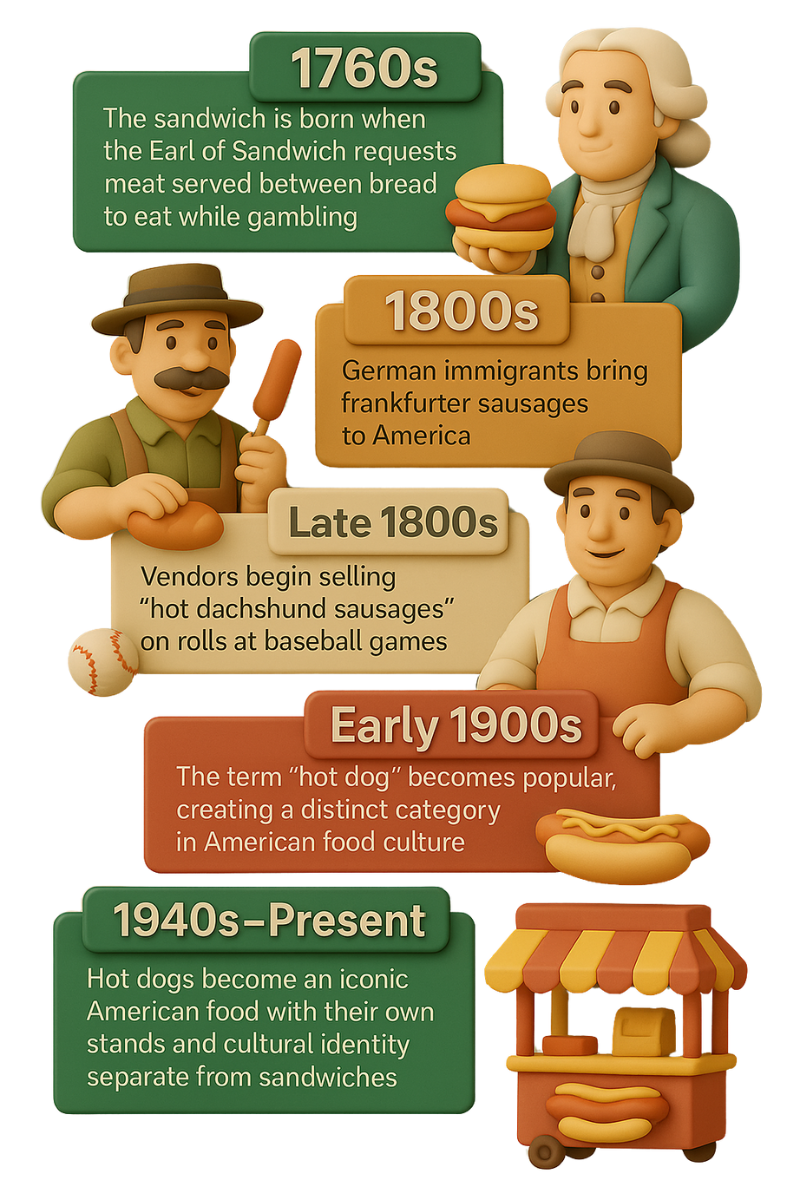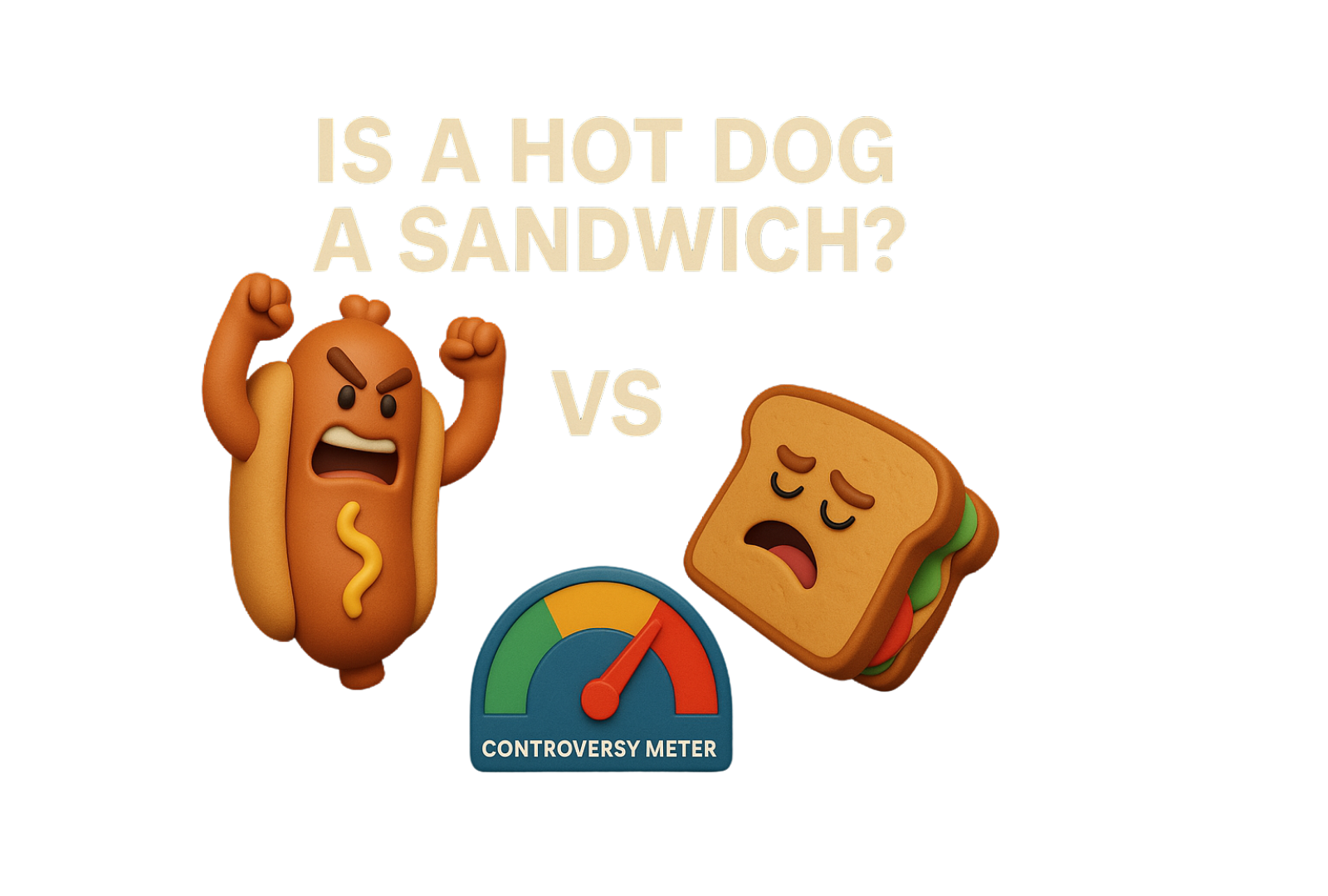
Exploring the food identity crisis that's dividing the culinary world

Exploring the food identity crisis that's dividing the culinary world
Welcome to one of the most contentious food debates of our time. The question seems simple: Is a hot dog a sandwich? Yet this culinary conundrum has sparked passionate arguments at dinner tables, online forums, and even scholarly discussions.
We've analyzed extensive data from surveys, debates, and linguistic patterns to bring you the definitive answer, backed by science and cultural analysis.
At first glance, the hot dog-sandwich debate might seem trivial, but it reveals fascinating insights about:
One of the key arguments in this debate centers around the structure of the bun. Traditional sandwiches have two separate pieces of bread, while a hot dog bun is typically connected. See what happens when we transform the structure in 3D:
Hot Dog Mode
A significant point in the debate is the connected nature of the hot dog bun. Traditional sandwiches use two completely separate pieces of bread, while the typical hot dog bun is a single piece that's been sliced but remains connected on one side.
Some argue that this structural difference fundamentally disqualifies the hot dog from sandwich status, while others suggest that the function (containing fillings between bread) is more important than the technical structure.
An intriguing perspective in our data suggests that a hot dog exists in a state of potential transformation: it becomes a sandwich the moment the bun splits into two separate pieces.
This raises a fascinating philosophical question: Can food change categories based on incidental structural changes during consumption, or should classification be based on intended design?
Food classification isn't solely about physical attributes—culture plays a crucial role in how we categorize culinary items. Hot dogs have developed their own distinct cultural category separate from sandwiches.
This distinction is evident in everyday language: we go to "hot dog stands," not "sandwich shops" for this food. The National Hot Dog and Sausage Council (yes, that's a real organization) firmly declares that hot dogs are not sandwiches but exist in a category of their own.
Understanding the evolutionary path of the hot dog provides important context. Hot dogs evolved from German sausage traditions, while sandwiches trace their lineage to the Earl of Sandwich in 18th century England.
These parallel but distinct culinary histories suggest that forcing hot dogs into the sandwich category might be an oversimplification that ignores rich cultural heritage and distinct culinary traditions.

The above structural and cultural insights allow us to determine if a hot dog is a sandwich. According to our analysis, these are the key criteria:
Let's examine how a hot dog measures up against these sandwich criteria:
We've analyzed extensive survey data to understand where public opinion stands on this crucial issue.
Based on survey data from 501 respondents
Our analysis shows that hot dogs have a controversy score of 0.517, which places them higher on the controversy scale, significantly above other debated food items like tacos (0.437) and more than double the score of curry (0.187).
Our data reveals interesting patterns in how people classify foods. The most common perspective (held by 290 respondents) can be characterized as "Sandwich Traditionalist," which strictly adheres to traditional definitions of food categories.
We identified two primary dimensions people use when categorizing foods: their sandwich classification approach (ranging from Traditionalist to Expansionist) and their intent classification approach (whether physical form or creator intent matters more).
Let's examine the strongest arguments from both sides of this culinary controversy.
After analyzing the data, weighing the arguments, and considering both structural and cultural perspectives, we've reached a conclusion based on the evidence:

While hot dogs share some characteristics with sandwiches, the connected nature of the bun, the distinct cultural categorization, and the overwhelming consensus in our survey data (62.5% say "No") all point to the hot dog existing in its own unique food category.
Hot Dog's Controversy Score: 0.517 out of 1.0
This debate reveals how food categories blend structural, functional, cultural, and historical elements. It shows that categorization is rarely based on rigid definitions alone.
The hot dog controversy demonstrates how we often rely on prototype theory when categorizing items—comparing foods to typical examples rather than checking off criteria from strict definitions.
The hot dog-sandwich debate illustrates how food categories can be culturally bounded, with disagreement arising when applying categories from one culinary tradition to foods from another.
This pattern extends beyond hot dogs to other cross-cultural food categorizations, revealing the cultural specificity of our food taxonomy.
Language evolves through usage, not technical definitions. The fact that most people don't refer to hot dogs as sandwiches in everyday speech is a strong indicator of their distinct categorical status.
This reflects the descriptive (how language is actually used) versus prescriptive (how language "should" be used) approach to linguistics.
| Topic | Key Terms | Weight |
|---|---|---|
| Pizza-Stew-Curry Analysis | pizza, stew, curry, soup, two | 304.51 |
| Hot Dog Sandwich Debate | hot, dog, sandwich, consider, soup | 26.02 |
| Food Serving Context | eaten, rice, response, curry, served | 25.70 |
| Food Structure Analysis | bread, think, liquid, ingredients, broth | 20.32 |
| Food Classification | response, yes, sure, calzone, sandwich | 141.37 |
| Food Classification Approach | Description | Prevalence |
|---|---|---|
| Sandwich Traditionalist | Requires separate bread pieces, strictly adheres to conventional definitions | High (58%) |
| Sandwich Expansionist | Accepts non-traditional forms as sandwiches based on function rather than structure | Medium (25%) |
| Sandwich Moderate | Takes a middle-ground approach with some flexibility in definitions | Low (17%) |
| Form-Over-Intent Prioritizer | Classifies foods based on physical attributes regardless of creator intention | Medium (32%) |
| Creator-Intent Prioritizer | Believes the creator's intention determines a food's classification | Medium (31%) |
| Intent Moderate | Balances physical attributes with creator intent when classifying foods | High (37%) |
Our analysis categorizes respondents based on how they approach food classification across two key dimensions: sandwich classification philosophy and the importance of creator intent.
Each respondent's answers contribute to two separate scores that determine their classification:
A respondent who answers "No" to hot dog being a sandwich (-1), "No" to split bun question (-0.8), requires 3+ ingredients (-1), believes tacos are never sandwiches (-1), slightly prefers open-faced sandwiches (-0.5), and says "No" to pizza sandwich (-1) would have a total score of -5.3. This would make them a strong "Sandwich Traditionalist."
If the same respondent rates chef intent importance as 2 out of 5 (0.4), they would be classified as an "Intent Moderate."
Our analysis shows that some questions had much stronger influence on classification than others:
Distribution of Classifications: Among our 501 respondents, 290 (58%) were classified as Sandwich Traditionalists, 86 (17%) as Sandwich Moderates, and 125 (25%) as Sandwich Expansionists. Regarding intent, 162 (32%) were Form-Over-Intent Prioritizers, 186 (37%) were Intent Moderates, and 153 (31%) were Creator-Intent Prioritizers.
The controversy score is a measure of how contentious a food item's classification is, based on four key factors:
Key Insights: Hot dog (0.517) has a higher controversy score than curry (0.187), primarily due to the vote closeness factor (0.886) from survey responses to questions about whether a hot dog is a sandwich.